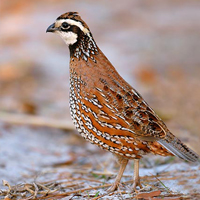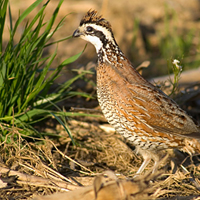Northern bobwhite
Scientific name: Colinus virginianus


Cover photos credit: Brian Small (left) and Bryan Eastham, Shutterstock (right)
Status
Endangered
“Endangered” means the species lives in the wild in Ontario but is facing imminent extinction or extirpation.
Date added to the Species at Risk in Ontario List
The Northern bobwhite was already assessed as endangered when the Endangered Species Act took effect in 2008.
What it looks like
The Northern bobwhite is a small quail with a rounded body and a stubby tail.
They are mostly a mix of greys, rust and brown.
Their most obvious feature is the striking head pattern with a bright white “eyebrow” and throat patch (tan in the female), divided by a black “mask”.
This quail is named for its unique call – a loud, clear whistle that sounds like “bob-white” with the emphasis on “white”.
These birds will sometimes try to escape a threat by running away or they may sit tightly in cover hoping to elude detection and then burst into flight if threatened.
Where it lives
Northern bobwhites live in savannahs, grasslands, around abandoned farm fields, along brushy fencerows and other similar sites.
Grasslands that are occasionally burned are particularly important because the fires help keep the habitat from becoming too forested.
In such places, bobwhites can find most of their needs such as food, nesting cover, and places to hide and rest throughout the year.
In severe winter conditions bobwhites sometimes need to move into small forest areas to find snow-free areas for foraging.
Bobwhites lay up to 16 eggs in a shallow natural depression that they line with plant material and conceal with grasses and vines.
Where it’s been found in Ontario
The Northern bobwhite is near its northern range limit in southern Ontario.
This bird benefited greatly when the original forests were cleared and it expanded its range significantly in Ontario.
At its peak over a century ago, its range in Ontario extended north to Georgian Bay and east to Kingston.
This range has steadily retracted and now includes only the southwest corner of the province, mostly on Walpole Island, and possibly a few scattered locations nearby.
Isolated sightings away from this area are usually a result of introductions or birds escaping from captivity.
View a Larger version of this map (PDF)
What threatens it
The main threat to the Northern bobwhite is loss of habitat due to intensive agriculture practices and urban development.
Because the Northern bobwhite is near the northern limit of its range in Ontario, large numbers are occasionally killed by severe cold, deep snow or similar extreme weather events.
Dogs and cats are also an increasing problem for this species as rural housing continues to encroach on their habitat.
Action we are taking
Endangered Species and their general habitat are automatically protected.
Recovery strategy
A recovery strategy advises the ministry on ways to ensure healthy numbers of the species return to Ontario.
Read the executive summary and the full document (December 5, 2019).
Government response statement
A government response statement outlines the actions the government intends to take or support to help recover the species.
Read the government response statement (September 8, 2020)
Habitat protection
General Habitat Protection - June 30, 2008
What you can do
Report a sighting
- Report a sighting of an endangered animal or plant to the Natural Heritage Information Centre. Photographs with specific locations or mapping coordinates are always helpful.
- Bird Studies Canada is working to advance the understanding, appreciation and conservation of wild birds and their habitat in Ontario and elsewhere - for more information on how you can help, visit:
www.bsc-eoc.org.
Volunteer
Volunteer with your local nature club or provincial park to participate in surveys or stewardship work focused on species at risk.
Be a good steward
- private land owners have a very important role to play in species recovery; if you find a Northern bobwhite on your land, you may be eligible for stewardship programs that support the protection and recovery of species at risk and their habitats
- the Canada-Ontario Farm Stewardship Program is available to farmers registered under the Canada-Ontario Environmental Farm Plan to encourage greater protection and conservation of habitat for species at risk
Report illegal activity
Report any illegal activity related to plants and wildlife to
Quick facts
- the male and female select the location for the nest and build it together; both parents share the tasks of incubating eggs and caring for the young, however, it is not uncommon for one of the parents to incubate the first clutch once complete (often the male) while the other leaves to take another mate and start another clutch
- the size of the Northern bobwhite population in Ontario is hard to estimate, in part because some observations are of captive-raised birds that have escaped or been released. Captive-raised birds do not survive very well in the wild
- over the last 30 years, the Northern bobwhite population has been almost wiped out in the province; in the 1970s, ice storms and heavy snowfall caused many bobwhite deaths in southwestern Ontario; the population has failed to recover even though there has been some habitat restoration within the bobwhite’s historic range in Ontario
- Walpole Island is considered to have one of the last remaining populations of bobwhites in Ontario; a survey of calling males conducted on Walpole Island in 2000 found fewer than 100 birds
